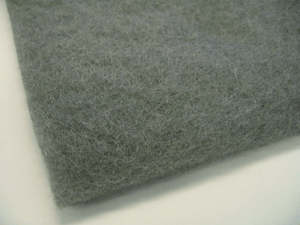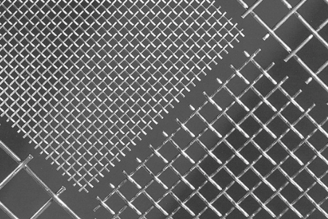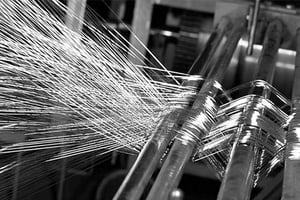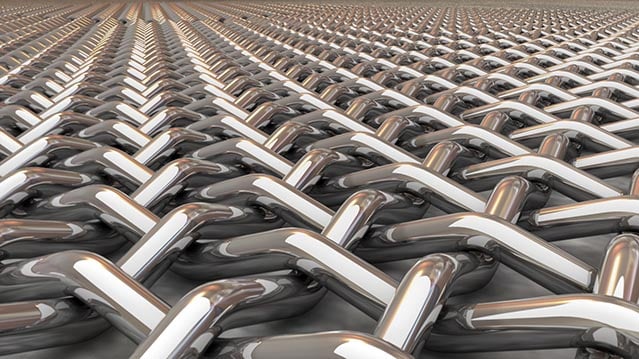Metal Fiber Felt vs Woven Wire Mesh Filters (Pros, Cons, and Cost)
Filtration operators and floor engineers strive to maintain an effective filtration system. To do so, you must use a filter medium that filters out contaminants while generating an even distribution of pressure.
From metal fiber felt to custom woven wire mesh filters, dozens of solutions can improve the efficiency of your operation. Knowing that, how exactly do metal fiber felt and woven wire mesh differ?
Here at W.S. Tyler, we have over 150 years of woven wire mesh experience and take pride in offering high-quality solutions.
In this article, we will define what metal fiber felt is, define what woven wire mesh is, identify the benefits and disadvantages of both, and provide insight into any price differences you can expect.
What Is Metal Fiber Felt?
Metal fiber felt is a three-dimensional filtration medium that consists of hundreds of metallic fibers. When bonded together, these fibers create pore openings small enough to deliver high-quality filtration. 
Now, when it comes to the alloy used to construct the fibers, manufacturers often use similar materials used to construct woven wire mesh. This means stainless steel is the primary alloy used.
That said, manufacturers can use other corrosion-resistant materials, such as Hastelloy.
To form metal fiber felt, the manufacturer starts by taking the desired alloy and breaking it down into a fiber-like form. These metallic fibers are then cut into small pieces and penetrated with needles to thread them together.
Once knitted together, the metal fiber felt gets sintered to create a permeate bond between the individual fibers.
To gain a better understanding of what alloy may be right for your application, discover the differences between stainless steel and hastealloy in the following article:
What Are the Benefits of Metal Fiber Felt?
One of the biggest advantages that metal fiber felt presents is that its pore size can be very fine. In fact, the pore size of metal fiber felt can reach 3-micron without any sacrifice in performance.
Another key advantage associated with the use of metal fiber felt is that it can be formed into various shapes. While woven wire mesh can be formed as well, it is much harder to work with.
When handled too much, the integrity of the wires and the mesh’s ability to filter contaminants can become compromised.
Metal fiber felt filters also have low electrical and heat conductivity. This makes them ideal for electrical applications and operations that filter hot materials.
What Are the Drawbacks of Metal Fiber Felt?
The biggest issue with metal fiber felt is that the pore openings are inconsistent. This is due to the fact that when assembled, the metal fibers get knitted together with no defined position.
When using a filter with random pore openings, the end product will contain inconsistent particle sizes.
Another major concern that occurs when applying metal fiber felt is its cleanability. As particles travel through the fibers of the felt, they become entangled and trapped.
No matter how you clean your filters, these particles will remain logged within the felt. As a result, metal fiber felt filters get replaced more than woven wire mesh filters.
What Is Woven Wire Mesh?
Woven wire mesh is a series of wires that are meticulously interlocked together through the use of a specialized weaving loom. The wire diameter, opening (aperture) size, micron rating, weave pattern, width, and length are fully customizable.
With pore openings reaching 4 micron, woven wire mesh is widely used as a metal filter cloth as it offers the durability needed to excel in harsh operations.
For a more comprehensive breakdown of what woven wire mesh is, read the article below:
Why Use Woven Wire Mesh?
 The biggest advantage that woven wire mesh has over metal fiber felt is that it provides the precision needed to achieve sharp cut-points. As a result, the end product complies with industry standards far better than if you were to use metal fiber felt.
The biggest advantage that woven wire mesh has over metal fiber felt is that it provides the precision needed to achieve sharp cut-points. As a result, the end product complies with industry standards far better than if you were to use metal fiber felt.
Another key advantage woven wire mesh has is that the pressure drop in the filtration system is a lot less than what metal fiber felt produces.
To explain this further, a certain amount of pressure is needed for material to pass through the filter. As metal fiber felt openings are random, material requires more pressure to pass through.
This is especially true after particles begin to build up within the filter.
Find out more about pressure drop and how it effects woven wire mesh fitlers, read the following article:
If your operation calls for the use of alloys, such as copper or brass, woven wire mesh is the only option when compared to metal fiber felt. This is because these alloys cannot withstand the sintering process that metal fiber felt undergoes.
What Are the Drawbacks of Woven Wire Mesh?
As stated above, woven wire mesh features openings that are far more defined than the openings of metal fiber felt. Creating these precise openings requires a heightened amount of labor, taking up to a week to set up the weaving loom alone.
As a result, woven wire mesh filters can have longer lead times.
While woven wire mesh consists of durable alloys, the mesh openings are delicate. If the mesh gets damaged in any way, odds are the mesh openings are no longer in spec.
When this happens, the filter will need replacement.
Because metal fiber felt is a three-dimensional in-depth filter, the pore openings are harder to compromise. Even if some fibers fall out of place, metal fiber felt will be able to deliver a desirable level of filtration.
How Does the Price Differ Between Metal Fiber Felt and Woven Wire Mesh?
From a price perspective, there is not a lot of difference between a wire mesh application and a metal fiber felt application. In fact, they are identical in price through and through.
Yet, when it comes to cost savings down the road, woven wire mesh holds the advantage. As woven wire mesh requires less back pressure to push material through, you will see reduced energy expenses.
Take Your Filtration Operation to New Heights
Selecting the right filtration medium to use in your operation is critical to the success of any filtration system. This allows your system to block the desired particle size and create pressure uniformity that reduces energy use.
Metal fiber felt filters consist of several metallic fibers. These fibers get sintered together to form a filter with randomized pore openings.
Its low electric and heat conductivity allows them to withstand extreme conditions.
Woven wire mesh is a series of interlocked wires that form precise openings. Providing accurate filtration, these filters allow you to maintain uniform throughput within your system.
Now, in order to properly integrate woven wire mesh into your operation, you must get to know the capabilities of wire mesh filters. W.S. Tyler has over 150 years of woven wire mesh experience and is here to help ensure you use a solution that will improve your filtration operation.
To gain insight into what can be achieved with wire mesh filters, read the following article:
About Ronnie Brown
Ronnie is the Content Writer for W.S. Tyler and has four years of experience as a professional writer. He strives to expand his knowledge on all things particle analysis and woven wire mesh to leverage his exceptional writing and graphic design skills, creating a one-of-a-kind experience for customers.




